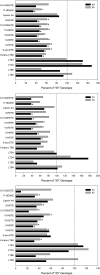ALOX5 gene variants affect eicosanoid production and response to fish oil supplementation
- PMID: 21296957
- PMCID: PMC3073473
- DOI: 10.1194/jlr.P012864
ALOX5 gene variants affect eicosanoid production and response to fish oil supplementation
Abstract
The objective of this study was to determine whether 5-lipoxygenase (ALOX5) gene variants associated with cardiovascular disease affect eicosanoid production by monocytes. The study was a randomized, double-masked, parallel intervention trial with fish oil (5.0 g of fish oil daily, containing 2.0 g of eicosapentaenoic acid [EPA] and 1.0 g of docosahexaenoic acid [DHA]) or placebo oil (5.0 g of corn/soy mixture). A total of 116 subjects (68% female, 20-59 years old) of African American ancestry enrolled, and 98 subjects completed the study. Neither ALOX5 protein nor arachidonic acid-derived LTB4, LTD4, and LTE4 varied by genotype, but 5-hydroxyeicosatetraenoate (5-HETE), 6-trans-LTB4, 5-oxo-ETE, 15-HETE, and 5,15-diHETE levels were higher in subjects homozygous for the ALOX5 promoter allele containing five Sp1 element tandem repeats ("55" genotype) than in subjects with one deletion (d) (three or four repeats) and one common ("d5" genotype) allele or with two deletion ("dd") alleles. The EPA-derived metabolites 5-HEPE and 15-HEPE and the DHA-derived metabolite 17-HDoHE had similar associations with genotype and increased with supplementation; 5-HEPE and 15-HEPE increased, and 5-oxo-ETE decreased to a greater degree in the 55 than in the other genotypes. This differential eicosanoid response is consistent with the previously observed interaction of these variants with dietary intake of omega-3 fatty acids in predicting cardiovascular disease risk.
Figures





References
-
- Boyce J. A. 2008. Eicosanoids in asthma, allergic inflammation, and host defense. Curr. Mol. Med. 8: 335–349. - PubMed
-
- Murphy R. C., Gijon M. A. 2007. Biosynthesis and metabolism of leukotrienes. Biochem. J. 405: 379–395. - PubMed
-
- Teiber J. F., Draganov D. I., La Du B. N. 2003. Lactonase and lactonizing activities of human serum paraoxonase (PON1) and rabbit serum PON3. Biochem. Pharmacol. 66: 887–896. - PubMed
-
- Connelly P. W., Picardo C. M., Potter P. M., Teiber J. F., Maguire G. F., Ng D. S. 2011. Mouse serum paraoxonase-1 lactonase activity is specific for medium-chain length fatty acid lactones. Biochim. Biophys. Acta. 1811: 39–45. - PubMed
Publication types
MeSH terms
Substances
Grants and funding
LinkOut - more resources
Full Text Sources
Research Materials

